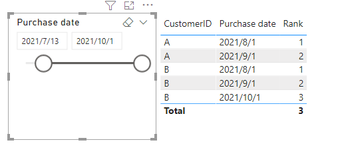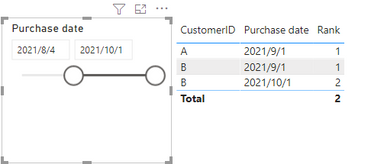FabCon is coming to Atlanta
Join us at FabCon Atlanta from March 16 - 20, 2026, for the ultimate Fabric, Power BI, AI and SQL community-led event. Save $200 with code FABCOMM.
Register now!- Power BI forums
- Get Help with Power BI
- Desktop
- Service
- Report Server
- Power Query
- Mobile Apps
- Developer
- DAX Commands and Tips
- Custom Visuals Development Discussion
- Health and Life Sciences
- Power BI Spanish forums
- Translated Spanish Desktop
- Training and Consulting
- Instructor Led Training
- Dashboard in a Day for Women, by Women
- Galleries
- Data Stories Gallery
- Themes Gallery
- Contests Gallery
- Quick Measures Gallery
- Notebook Gallery
- Translytical Task Flow Gallery
- TMDL Gallery
- R Script Showcase
- Webinars and Video Gallery
- Ideas
- Custom Visuals Ideas (read-only)
- Issues
- Issues
- Events
- Upcoming Events
Calling all Data Engineers! Fabric Data Engineer (Exam DP-700) live sessions are back! Starting October 16th. Sign up.
- Power BI forums
- Forums
- Get Help with Power BI
- Desktop
- Need help - how to rank based on filter and group ...
- Subscribe to RSS Feed
- Mark Topic as New
- Mark Topic as Read
- Float this Topic for Current User
- Bookmark
- Subscribe
- Printer Friendly Page
- Mark as New
- Bookmark
- Subscribe
- Mute
- Subscribe to RSS Feed
- Permalink
- Report Inappropriate Content
Need help - how to rank based on filter and group by specific column?
Many thanks for your help in advance
raw data is like the following:
after setting the filter: purchase date between 202108-202110, how can I get the following result?
(filter data that purchase date between 202108-202110, and rank by customerID)
Solved! Go to Solution.
- Mark as New
- Bookmark
- Subscribe
- Mute
- Subscribe to RSS Feed
- Permalink
- Report Inappropriate Content
@uir , My bad,
You needed coutrows
countrows(filter(allselected(Table), Table[Customer] = max(Table[Customer ID]) && Table[Purchase Date] <= Max(Table[Purchase Date]) ) )
- Mark as New
- Bookmark
- Subscribe
- Mute
- Subscribe to RSS Feed
- Permalink
- Report Inappropriate Content
@uir can you try this measure?
Rank =
RANKX (
FILTER ( ALLSELECTED ( tbl ), tbl[custID] = MAX ( tbl[custID] ) ),
[_maxPurchaseDate],
,
ASC
)
- Mark as New
- Bookmark
- Subscribe
- Mute
- Subscribe to RSS Feed
- Permalink
- Report Inappropriate Content
Hi, @uir
You can try the following methods.
Measure:
Rank =
CALCULATE (
COUNT ( 'Table'[CustomerID] ),
FILTER (
ALLSELECTED ( 'Table' ),
[CustomerID] = MAX ( 'Table'[CustomerID] )
&& [Purchase date] <= MAX ( 'Table'[Purchase date] )
)
)Is this the output you expect?
Best Regards,
Community Support Team _Charlotte
If this post helps, then please consider Accept it as the solution to help the other members find it more quickly.
- Mark as New
- Bookmark
- Subscribe
- Mute
- Subscribe to RSS Feed
- Permalink
- Report Inappropriate Content
Hey @uir ,
creating maeasure like this, requires a data model instead of a single table. For this reason i created two additional tables:
- Customer and
- Date
I created relationships between the new tables and the existing one (the table that contains the sample data). I called the existing table: fact. The screenshot below shows the data model:
Then I created the measure below:
Measure =
var outerGroupElement = MAX( 'Customer'[CustomerID] )
var innerGroupTable = CALCULATETABLE( VALUES( 'Fact'[Purchase Date] ) , ALLSELECTED( 'Date'[Date] ) )
var __t =
GENERATE(
VALUES( 'Customer'[CustomerID] )
, innerGroupTable
)
var __t1 =
ADDCOLUMNS(
__t
, "rk"
, rankx( __t
, CALCULATE( MAX('Fact'[Purchase Date] )
, ALL( 'Date' )
)
,
, ASC
)
)
return
IF( MAX( 'Date'[Date] ) in innerGroupTable
, var cid = MAX( 'Customer'[CustomerID] )
var pd = MAX( 'Date'[Date] )
return
MAXX( FILTER( __t1 , [CustomerID] = cid && [Purchase Date] = pd) , [rk] )
, BLANK()
)
This allows to create a simple report like below:
Be aware that the visuals (slicer, table) are using columns from the new tables instead of the columns from the old table.
Hopefully, this provides some new ideas on how to tackle your challenge.
Regards,
Tom
Did I answer your question? Mark my post as a solution, this will help others!
Proud to be a Super User!
I accept Kudos 😉
Hamburg, Germany
- Mark as New
- Bookmark
- Subscribe
- Mute
- Subscribe to RSS Feed
- Permalink
- Report Inappropriate Content
@uir , You can use filter on purchase date
or create this into date and use a filter on connected date table
date = date(left([purchase Date],4), right([purchase date],2) ,1)
You can not get that with Rank,
So create a measure
countx(filter(allselected(Table), Table[Customer] = max(Table[Customer ID]) && Table[Purchase Date] <= Max(Table[Purchase Date]) ) )
- Mark as New
- Bookmark
- Subscribe
- Mute
- Subscribe to RSS Feed
- Permalink
- Report Inappropriate Content
countx need 2 parameters, however, it seems that your measure only have 1, could u plz share the 2nd parameter?
- Mark as New
- Bookmark
- Subscribe
- Mute
- Subscribe to RSS Feed
- Permalink
- Report Inappropriate Content
@uir , My bad,
You needed coutrows
countrows(filter(allselected(Table), Table[Customer] = max(Table[Customer ID]) && Table[Purchase Date] <= Max(Table[Purchase Date]) ) )
Helpful resources

FabCon Global Hackathon
Join the Fabric FabCon Global Hackathon—running virtually through Nov 3. Open to all skill levels. $10,000 in prizes!

Power BI Monthly Update - September 2025
Check out the September 2025 Power BI update to learn about new features.









